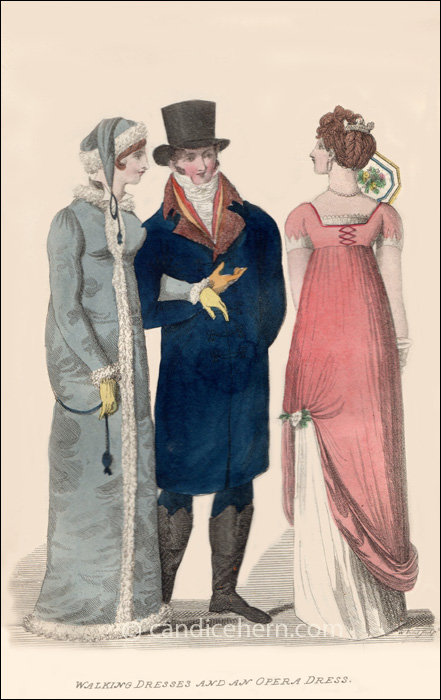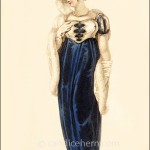Le Beau Monde, February 1808.
 “Walking Dresses and an Opera Dress.”
“Walking Dresses and an Opera Dress.”
The dress on the right, named an Opera Dress in the print title, is referred to as a Full Dress in the description. The fabrics and jewelry would be appropriate for Full Dress. But Opera Dresses are generally categorized as Half Dress, so once again, the terms are a bit confusing.
The print is described in the magazine as follows:
“Fig. No. 1– MORNING WALKING DRESS.–The Hindu coat and hat made of dove or bright grey coloured sarsnet, or fine cloth trimmed all round with a rich fur trimming of a fancy colour; the coat is made straight over the bosom, square across the shoulders, and continues with a small peak in the centre of the back; it is brought tight round the waist to the form of the shape, a high collar with long peaks in front to fall all over the neck, ornamented with small silk tassels, fastened to each corner. A rich cord and tassel or confined in the back, and hang carelessly in the hand; the coat is lined all through with white sarsnet, and confined together down the front; gloves white Woodstock, and shoes of the same colour as the coat.
“Fig. No. 2–OPERA DRESS–The most distinguished full dress is composed of a magnificent cloth of deep pink, worn over a white satin slip; the dress is made round and short, with a square back on the top and at the bottom of the waist, which is rather increased in length; the skirt is made entirely plain, and is laced down the back with small pink beads, in the form of diamonds; the honey-comb front, made to the form of the bosom, short sleeves straight over the shoulders, and at the back; broad Vandyke at the bottom of the sleeves of white satin, ornamented round the neck and in different parts in the Kolana style; the dress caught up and fastened with a bunch of silver roses and green foil on the back of the left side above the knee, and hangs in loose folds round the bottom, about a quarter of a yard distant from the bottom of the petticoat, on the right side. The hair is combed straight from the crown of the head behind, and is formed into a thick twist, which is confined with a rich diamond comb, on the top of which three gold crowns are placed; the ends of the hind hair are seen in pendant ringlets falling over the left side of the head; on the front of the forehead the hair is divided, and lays smooth over the right temple, and is kep back by the Kolana crescent. Necklace and ear-rings of diamonds; gloves white kid; and shoes white satin.”
There is no specific description of the gentleman’s dress, but there is a section on Gentlemen’s Dress which includes certain details that appear to relate to the print:
“Blue pantaloons are again coming much into wear, and will generally be worn during the winter season, but they have no kind of ornament or trimming on the front.–Hussar boots are, of course worn with panataloons … Dark blue great coats trimmed with fur, or darkish olive brown cloth great coats are generally worn.”







